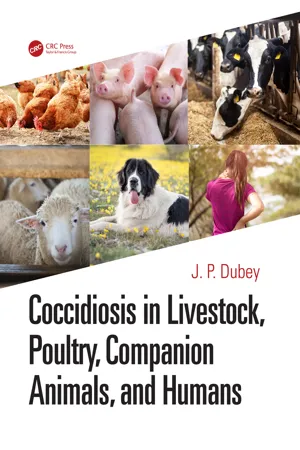
- 380 pages
- English
- ePUB (mobile friendly)
- Available on iOS & Android
Coccidiosis in Livestock, Poultry, Companion Animals, and Humans
About This Book
Coccidiosis is one of the most important diseases of livestock, particularly poultry, with billions of dollars spent on prevention worldwide. The disease is so important and pervasive that until recently, all poultry feed was medicated with coccidiostats, mainly antibiotics. With the rapid development of drug resistance, the search is on for alternative methods of control of coccidiosis in poultry. With chapters authored by internationally renowned scientists, this book covers coccidiosis in all major livestock species, including cattle, sheep, and goats. Special emphasis is given to poultry coccidiosis given the significant economic impact, and another chapter looks at intestinal coccidiosis in humans, including Cyclospora. Chapters discuss techniques, molecular biology, host-pathogen immunobiology and immunoprophylaxis, genetics and genomics, biology, and chemotherapy.
Despite an explosion of research in the last 40 years, there has been no new book published discussing conventional coccidiosis for more than 25 years. This comprehensive review therefore answers an urgent need for a book dealing exclusively with conventional coccidia ( Cystoisospora, Cyclospora ). It provides concise, authoritative, up-to-date information on coccidiosis, with particular attention given to research in the last 28 years.
This book is essential reading for any practitioner or researcher involved in livestock production, including biologists, veterinarians, parasitologists, and researchers from government, academia, and industry.
Frequently asked questions
Information
Table of contents
- Cover
- Half Title
- Endorsements
- Title Page
- Copyright Page
- Dedication
- Contents
- Preface
- Editor
- Contributors
- Chapter 1: Biology of Intestinal Coccidia
- Chapter 2: Phylogeny of Coccidian Parasites
- Chapter 3: Host Immunity in Coccidiosis
- Chapter 4: Vaccination
- Chapter 5: Genomics, Transcriptomics, and Proteomics of the Eimeria Species
- Chapter 6: Anticoccidial Drugs of Livestock and Poultry Industries
- Chapter 7: Coccidiosis in Cattle
- Chapter 8: Coccidiosis in Water Buffaloes (Bubalus bubalis)
- Chapter 9: Coccidiosis in Sheep
- Chapter 10: Coccidiosis in Goat (Capra hircus)
- Chapter 11: Coccidiosis of Pigs
- Chapter 12: Coccidiosis in Old World Camels
- Chapter 13: Coccidiosis in South American Camelids
- Chapter 14: Coccidiosis in Rabbits (Oryctolagus cuniculus)
- Chapter 15: Coccidiosis in Chickens (Gallus gallus)
- Chapter 16: Coccidiosis in Poultry in China
- Chapter 17: Coccidiosis in Turkeys (Meleagris gallopavo)
- Chapter 18: Coccidiosis in Ducks (Anas spp.)
- Chapter 19: Coccidiosis in Horses and Other Equids
- Chapter 20: Coccidiosis in Dogs (Canis familiaris)
- Chapter 21: Coccidiosis in Cats (Felis catus)
- Chapter 22: Coccidiosis in Humans
- References
- Index